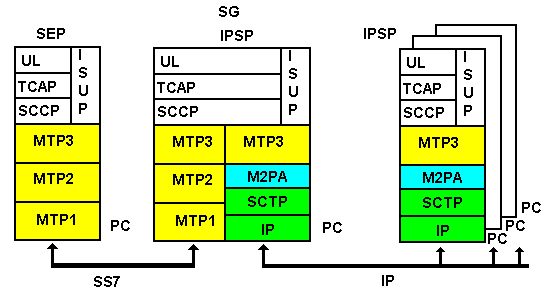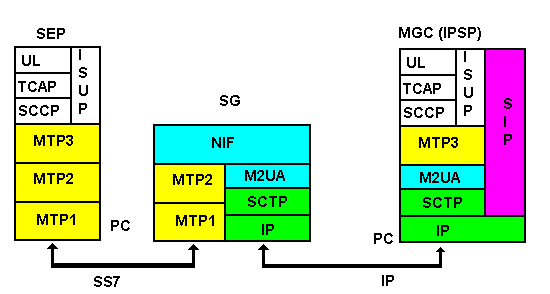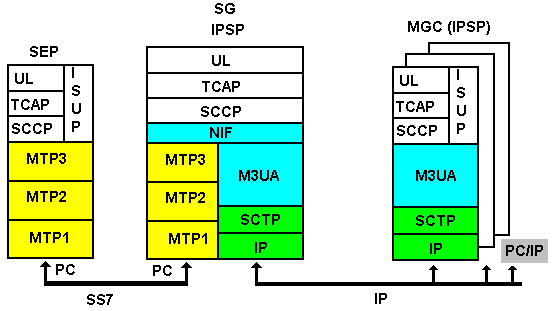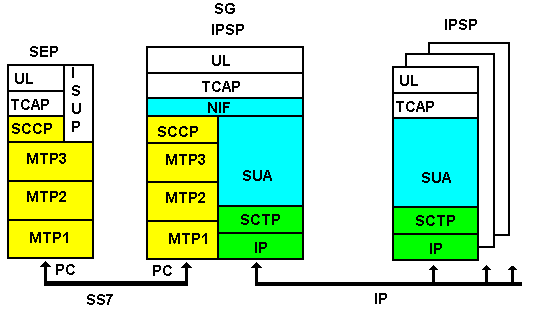Tech Stuff - SIGTRAN (SS7 over IP)
Common Channel Signaling System #7 ( SS7) transports SS7 messages over an SS7 network (normally a DS0A connection) and then there is SIGTRAN. SIGTRAN is a set of protocols defined to transport SS7 messages over IP networks. SIGTRAN allows IP networks to inter-work with the Public Switched Telephone Network (PSTN) and vice versa.
ZYTRAX now offers SIGTRAN and SS7 training.
Notes: There are two other IETF standards which define transport of PSTN signaling (non-SS7) over IP networks: ISDN User Adaption (IUA) which provides adaption at the the Q.921 layer to allow transparent transport of Q.931 messages to, say, a VoIP gateway. IUA is defined by RFC4233. V5.2 User Adaption (V5UA) which provides for the transport of ETSI standard V5.2 messages in an IP network by adaption at the LAPV5 level. V5UA is defined by RFC3807.
Contents
- SIGTRAN Stack
- SCTP Overview
- M2PA Adaption Layer
- M2UA Adaption Layer
- M2UA vs M2PA Adaption
- M3UA Adaption Layer
- SUA Adaption Layer
- SS7 & SIGTRAN Glossary
The SIGTRAN Protocol Stack, RFC 2719
The SIGTRAN protocol stack consists of 3 components:
A standard IP layer.
A common signaling transport protocol, Stream Control Transmission Protocol (SCTP): SCTP provides connection oriented reliable transfer of user messages between peer SCTP users (Adaptation layer protocols). Note: The SCTP layer replaces a normal TCP/UDP layer.
An Adaptation layer: Protocols defined for this layer are M2PA, M2UA, M3UA, and SUA.
="center" src="images/sigtran.jpg" alt="">
Figure 1: SIGTRAN Protocol Stack Model

SCTP (Stream Control Transmission Protocol)
Defined by RFC 3309 and RFC 4166. SCTP is designed to transport SS7 signaling messages over IP networks. It operates directly on top of IP at the same level as TCP. SCTP's basic service is connection oriented reliable transfer of messages between peer SCTP users. SCTP offers the following services (not exhaustive) that may be used by SIGTRAN:
Multi-homing: is the ability of an association (that is, a connection) to support multiple IP addresses or interfaces at a given end point. In case of network failures, use of more than one address can allow re-routing of packets, and also provide an alternate path for retransmissions. End-points exchange lists of addresses during initiation of the connection. One address is designated as the primary address to receive data. A single IP port number is used across the entire address list at an endpoint for a specific session.
Multi-streaming (Chunking): Allows for multiple virtual connections on the same physical line. Each user application might be assigned its own stream (virtual connection). SCTP's multi-streaming allows data to be delivered in multiple, independent streams, so that if there is data loss in one stream, delivery will not be affected for the other streams. The SCTP user can specify at startup time the number of streams to be supported by the association.
Sequenced Delivery: Allows for messages to be delivered in the order in which there were sent.
Block-Level: Unlike TCP in which transmission is viewed as a continuous stream of data, SCTP transmits blocks.
Self-Fragmentation: SCTP uses MTU path discovery to ensure that messages are not fragmented by intermediate nodes.
Heart-Beat: SCTP uses periodic heart-beat messages to confirm the status of each end point.
Adaptation Layer / SCTP Boundary
Primitives for this interface are defined in the RFC 2960, Section 10.

M2PA (MTP2 Peer-to-Peer Adaptation Layer)
Defined by RFC 4165. MP2A is a protocol which supports the transport of SS7 MTP3 signaling messages over IP using the services of the SCTP. M2PA operates similarly to MTP2 so as to provide peer-to-peer communication between SS7 endpoints. M2PA extends the SS7 network into the IP network in a manner transparent to the SS7 network. Because the MTP3 layer (which routes on point codes) is present in all Signaling Points each IPSP requires a point code.

Figure 1 - M2PA Adaption Layer
SEP = Signaling End Point ( for example, an SSP)
IPSP = IP Signaling Point
SG = Signaling Gateway
Notes:
MTP3, which is preserved in every IPSP with M2PA, uses Point Codes as its address mechanism and thus all IPSP require a Point Code.
The term UL (Upper Layer) has been used to indicate any layer which runs over TCAP, for example, MAP.
With M2PA the SG may act as an STP simply routing messages (based on Point Codes) from the SS7 network to the IPSP (IP Signaling Point).
In essense M2PA adaption allows SS7 functionality to be located within an IP network.
The Signaling Gateway (SG) will be a fully function SS7 SP and therefore can have any SS7 functionality such as SCP, STP or SSP.
If ISUP is supported by any IPSP then it would be acting as a SSP and have a VoIP stack, such as SIP, which is not shown to keep the diagram simple.
Other STPs may be present in the path between the SEP (SSP) and the SG.
M2PA allows for one or more IPSP in the network. Each IPSP must have its own point code.
M2PA can transport any MTP3 user messages, for example, SCCP and ISUP).
M2PA supports all primitives between MTP3 and MTP2 and is essentially transparent to MTP3.
M2PA provides MTP2 functionality that is not provided by SCTP, so that together M2PA and SCTP provide functionality similar to that of MTP2.
Definition of the M2PA / MTP3 boundary
The primitives are described in Q.703, Q.704, T1.111, and Q.2140. These are the same primitives that define the MTP2/MTP3 boundary.
M2PA receives the primitives sent from MTP3 to its lower layer. M2PA processes these primitives or maps them to appropriate primitives at the M2PA/SCTP interface. Likewise, M2PA sends primitives to MTP3 like those used in the MTP3/MTP2 interface.

M2UA (MTP2 User Adaptation Layer)
Defined by RFC 3331. M2UA is a protocol for the backhauling of SS7 MTP3 messages over IP using the services of SCTP. This protocol is used between a Signaling Gateway (SG) and a Media Gateway Controller (MGC) such as a VoIP gateway but it could equally well be SCP.

Figure 2 - M2UA Adaption Layer
SEP = Signaling End Point (An SSP)
SG = Signaling Gateway
NIF = Nodal Inter-working Function
IPSP = IP Signaling Point
MGC = Media Gateway Controller: A device that converts from one protocol to another.
Notes:
With M2UA the SG functions as a transparent relay that converts SS7 messages to IP format.
All SPs in the SS7 domain have Point codes. Only the MGC (IPSP) in the IP domain has a Point Code (it has an MTP3 layer). The SG does not have a Point Code (since it has no MTP3 Layer).
Other STPs may be present in the SS7 path between the SEP and the SG.
The SG cannot have upper ISUP/SCCP layers because it has no MTP3 layer
The Nodal Inter-working Function (NIF) simply accepts messages from the MTP2 layer and writes them to the M2Ua layer. It is a 'glue' layer and its functionality is not defined by the standards.
With M2UA the IPSP's MPT3 uses the SG's MPT2 as its lower SS7 layer. Both MTP2 on the SG and MTP3 on IP signaling point remain unaware of the fact that their upper and lower layer respectively is not running locally.
The whole IP network is represented by a single point code that addresses the MGC at the network edge. Therefore all messages from the SS7 side going to the IP side are sent to the MGC through the SG. The MGC converts from the M2UA protocol to another protocol ( such as SIP or Megaco) and vise versa.
M2UA allows for only one IPSP (MGC) in the network.
Any messages that arrive at the SG, from the IP domain or SS7 domain are simply relayed to the SS7 or IP domain respectively.
While Figure 2 shows a SIP stack this would only be present is the IPSP were providing VoIP gateway functionality in the case of an SCP this function would not be present.
Definition of the M2UA / MTP3 boundary
Q.703, Q.704, Q.2140 ITU Recommendations
- DATA
- ESTABLISH
- RELEASE
- STATE
- DATA RETRIEVAL
- DATA RETRIEVAL COMPLETE
Definition of the M2UA / MTP2 boundary
Q.703, Q.704, Q.2140 ITU Recommendations
- DATA
- ESTABLISH
- RELEASE
- STATE
- DATA RETRIEVAL
- DATA RETRIEVAL COMPLETE
M2PA and M2UA Compared
M2PA and M2UA similarities:
Both transport MTP3 messages.
Both present an MTP2 upper interface to MTP3.
M2PA and M2UA differences:
M2PA: IPSP processes MTP3-to-MTP2 primitives.
M2UA: IPSP transports MTP3-to-MTP2 primitives between the SG's MTP2 and the IPSP's MTP3 (via the interworking function) for processing.
M2PA: SG is an SS7 node with a point code.
M2UA: SG is not an SS7 node and has no point code.
M2PA: SG can have upper SS7 layers, e.g., SCCP.
M2UA: SG does not have upper SS7 layers since it has no MTP3.
M2PA: may have one or more IPSPs.
M2UA: can only have one IPSP.
M2PA: SG can route to other SPs, perform Global Title Translation as well as provide application layer services.
M2UA: SG's single function is to relay MTP3 messages.

M3UA (MTP 3 User Adaptation Layer)
Defined by RFC 4666. M3UA supports the transport of any SS7 MTP3-User signaling (for example, ISUP and SCCP messages) to an IP Signaling Point (IPSP) using the services of SCTP. M3UA is IP aware in that it translates the contents of the incoming SS7 MSU using a Routing Key (a glorified routing table) to map to the relevant IP address.
When using M3UA, IPSPs (ASs) may, or may not, require point codes depending on the application. If the application uses, say, SCP functionality then the SSN may be used to address the required IPSP without any need for Point Codes. Alternatively if the application is a VoIP gateway (an SSP) whose point code is visible within the SS7 network then clearly a point code is required at the IPSP (AS).

Figure 3 - M3UA Adaption Layer
NIF = Nodal Inter-working Function
SEP = Signaling End Point (SSP)
Notes:
The SS7 SG in the M3UA scenario functions as an STP and can provide SCCP based services which could include Golbal Title Translation which may cause redirection to either the SS7 or IP network.
The SS7 SPs and the SG have Point Codes. The IPSPs may, or may not, have Point Codes depending on the supported application(s). If the supported applications are entirely SCP-oriented then message routing may be done within the IP network based on the SSN (and/or Transaction ID) in which case no Point Codes are required for IPSP functioning as SCPs. If the application(s) being supported use ISUP (for example, a VoIP gateway) and the end point is visible to the SS7 network then point codes are required for each IPSP functioning in this manner.
MTP3 and M3UA both provide routing capabilities. MTP3 routes from point code to point code. M3UA maps and routes point codes to IP addresses and vice versa using a Routing Key.
The Nodal Inter-working Function (NIF) (not defined by the standards) allows messages to be routed to a local SCCP based service, such as Global Title Translation, or to an IPSP based on the Routing Key.
When a message arrives at the SG, MTP3 or M3UA examines the DPC/OPC or the SIO/DPC/OPC set and routes the message via the NIF to the appropriate location. If the DPC is the same as the SG's Point Code, the message is sent to the layer above. If the DPC differs from the SG's Point code, the message is routed by the SG to its proper destination via the NIF.
ISUP messages are always routed by the SG, they can never be destined for the SG (or any STP).
An ISUP message from the SS7 network destined for the IP network, is sent by the SG's MTP3 to the local M3UA via the NIF. M3UA then routes the message to the appropriate IPSP. Similarly, an ISUP message from the SS7 network destined for the IP domain, is sent by the SG's M3UA to the local MTP3 also via the NIF. MTP3 routes the message back to the origination SP.
In the SG, if the result of an application request or a GTT yields an SCP address located in the SS7 domain or the IP domain, the resulting request is sent to the local MTP3 or M3UA respectively for proper routing.
M3UA provides functionality similar to MTP3 but routing is IP aware through the use of the Routing Key.
Boundary between M3UA and an MTP3-User (ISUP /SCCP)
From ITU Q.701:
- MTP-TRANSFER request
- MTP-TRANSFER indication
- MTP-PAUSE indication
- MTP-RESUME indication
- MTP-STATUS indication

SUA (SCCP-User Adaptation Layer)
Defined by RFC 3868. SUA defines a protocol for the transport of any SS7 SCCP-user signaling message such as TCAP, RANAP or MAP over IP using SCTP services.

Figure 4 - SCCP User Adaption Layer (SUA)
NIF = Nodal Inter-working Function
SEP = Signaling End Point (SCP)
MGC = Media Gateway Controller
Notes:
SUA can only transport SCCP-User messages
The SS7 SP, and the SG both have Point Codes. The IPSPs do not require point codes.
SUA cannot support ISUP and thus the IPSP cannot be an SSP.
SCCP and SUA layers interface at the SG
The NIF is not defined by the standards and acts as an intelligent router from UL's to either the SCCP or SUA.
It is assumed that using the Global Title, SSN (and/or Transaction IDs) the messages can be routed to one or more IPSPs which thus do not require point codes.
SG can either act as an end point (SCP) or an STP
Together with SCTP, SUA replaces SCCP & MTP.
Definition of SUA/SCCP the Boundary
Recommendation: ITU Q.711
SUA and M3UA Comparison
In general, the protocol stack based on SUA is less complex compared to the protocol stack based on SCCP and M3UA. SUA can enhance the efficiency of the network and provides a means for simpler implementations.
M3UA and SUA Differences:
M3UA: Needs the SCCP services.
SUA: Does not need SCCP services, reducing the complexity of the node and thereby reducing cost.
M3UA: Supports ISUP services.
SUA: Cannot support ISUP services.
M3UA: Each IP node is required to have a point code and an IP address.
SUA: Each IP node does not require a point code.
M3UA: Messages are handled from point code to point code.
SUA: Allows the IP network to route the messages using global title information or SSN.

Problems, comments, suggestions, corrections (including broken links) or something to add? Please take the time from a busy life to 'mail us' (at top of screen), the webmaster (below) or info-support at zytrax. You will have a warm inner glow for the rest of the day.
















